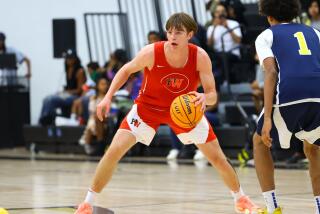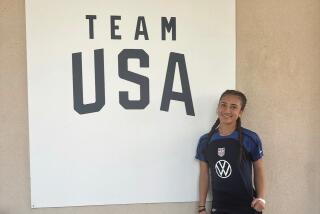COMMENTARY ON COLLEGE SPORTS : Why Do Budget Cuts Always Punish Scholar-Athlete Ideal? : Football and basketball lag behind lesser-known sports in graduation rates, but the ‘little guys’ feel the budget ax.
- Share via
Recent budget crises in the athletic departments of local universities, and the steps taken in response to them, serve to highlight what has been a fundamental problem with college athletics. That is, when budgets shrink, the first to feel it are the smaller, less visible teams, even though they may be more successful than the big money sports, even though team members may better represent the scholar-athlete ideal.
At Cal State Fullerton, Dick Wolfe, who coached men’s gymnastics for 23 years, recently quit when his salary was halved in the face of severe cutbacks. Many believe the team will be discontinued as a token belt-tightening measure.
At UC Irvine, no teams were dropped, but all were cut financially and five teams, including water polo, men’s soccer, men’s volleyball, crew and sailing were made self-supporting. At UCLA, successful water polo and crew teams were discontinued this year; at Cal State Long Beach, swimming, diving and men’s tennis and golf have been dropped, although boosters are mounting a fund-raising effort. Real improvements, however, better grades and more graduates, are seldom a major consideration in formulating NCAA and athletic department policy.
Oh, sure, much noise is made of their yearly lip service to reform. The Knight Commission recently recommended the NCAA publish information on graduation rates among athletes. The reports will be broken down by racial and ethnic categories, showing what has been obvious for a long time: Blacks are by far the biggest victims of the NCAA’s ham-handed management emphasizing athletics over scholarship.
And each year, token measures are adopted to divert criticism. The basketball season will be shortened to 25 games beginning next year, for example. But when it comes to meaningful reform, making changes that at the expense of profits would improve the student-athlete’s chances for graduating, the NCAA takes the low road.
Midweek basketball games on the road uproot players from the classroom, and then they are expected to catch up with hand-holding study halls. But there is so much money to be made through televising these games nothing is done to change a situation that is obviously detrimental to the players.
In many cases, these are marginal students to begin with. Winging across the country on Wednesday and coming back on Friday is obviously going to make a bad thing worse. Freshman ineligibility for athletes with marginal academic ability would ease the transition to college, but that would also cut into the bottom line.
The implied dual role of the student-athlete leads to the assumption that, even if he or she does not choose to take advantage of it, still the opportunity for an education is available to each collegiate athlete. However, it is clear that some college athletes do not belong in college classrooms--they simply haven’t had the academic training to compete in that arena. They go to school strictly to compete on the playing field or court; education is clearly not a concern.
Sometimes, they don’t even qualify academically for college--”Special Admits,” they are called. But they really are meal tickets, big-name players with the ability to draw fans and media attention--and thus dollars--to the schools they play for. Studies show few of these athletes actually make it in the high-dollar world of professional sports.
There is another class of student athletes, however. One which can, with only a few scattered exceptions, achieve academic success, the championship cup of which is the degree. A recently released survey illustrates the split.
Conducted by the Chronicle of Higher Education, the survey tracks for five years the class that entered college in 1984, noting what percentage of freshman athletes, as compared to the whole freshman class, graduated by August, 1989.
Some of the findings:
* Surprisingly, more than 56% of athletes at Division I (the highest level of competition) schools graduated in five years, while about 48% of all students received degrees.
* Basketball players had the lowest graduation rate at less than 39%.
* Major football teams graduated 42% of their 1984 freshmen.
* Duke, winner of the NCAA basketball championship April 1, graduated 96.1% of its male athletes during the survey period, while the team it defeated in the semifinals, defending champion Nevada-Las Vegas, graduated just one of seven male athletes it accepted in the five-year span.
* In both football and basketball, Cal State Fullerton was near the bottom. Over five years, just 8.7% of Fullerton’s 1984 freshman football players received degrees. Of the 262 responding schools with football teams, only four had lower graduation rates than Fullerton. No basketball players were graduated in that time. That was the case with several schools, however, as graduation rates for basketball vary wildly because so few freshmen join the team each year.
Clearly, however, if the athletes as a whole are graduating at a higher rate than all freshmen, the minor sports athletes are graduating at a level much higher than those in football and basketball.
At Cal State Fullerton, where 27.4% of the students graduated within five years, just 23.9% of recruited athletes received degrees in that time. In contrast, 29% of Fullerton student athletes in sports other than football, basketball and baseball graduated in five years or less.
Why then, is it that the minor sports--the ones that draw neither fame nor fortune--usually are hit hardest when budgets must be slashed? Doesn’t it make sense that the NCAA, which hypes the learning process in commercials at halftime of bowl games and other high-profile events, would reward the teams that best promote the association’s scholar-athlete charade?
Not if you approach it from the accountant’s point of view. After all, business is business. The bottom line is the bottom line. And so the sports that tend to do the best job of promoting the scholar-athlete concept are also the ones that lose their funding when the red ink flows.
More to Read
Go beyond the scoreboard
Get the latest on L.A.'s teams in the daily Sports Report newsletter.
You may occasionally receive promotional content from the Los Angeles Times.










